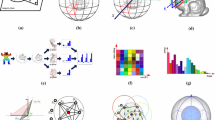Abstract
Interest point detectors typically operate on 2D images, yet these frequently constitute projections of real 3D scenes [8]. Analysing and comparing the performance of these detectors as to their utility at tracking points in a 3D space is challenging. This paper demonstrates a virtual 3D environment which can measure the repeatability of detected interest points accurately and rapidly. Real-time 3D transform tools enable easy implementation of complex scene evaluations without the time-cost of a manual setup or mark-up. Nine detectors are tested and compared using evaluation and testing methods based on Schmid [16]. Each detector is tested on 34 textured and untextured models that are either scanned from physical objects or modelled by an artist. Rotation in the X, Y, and Z axis as well as scale transformations are tested on each model, with varying degrees of artificial noise applied. Results demonstrate the performance variability of different interest point detectors under different transformations and may assist researchers in deciding on the correct detector for their computer vision application.
Access this chapter
Tax calculation will be finalised at checkout
Purchases are for personal use only
Preview
Unable to display preview. Download preview PDF.
Similar content being viewed by others
References
Beaudet, P.: Rotationally invariant image operators. In: Proc. Intl. Joint Conf. on Pattern Recognition, pp. 579–583 (1978)
Carlo Tomasi, T.K.: Detection and tracking of point features. In: Carnegie Mellon University Tech. Rpt (1991)
Förstner, W.: A feature based correspondence algorithms for image matching. Intl. Arch. Photogrammetry and Remote Sensing 24, 160–166 (1986)
Gauglitz, S., Hllerer, T., Turk, M.: Evaluation of interest point detectors and feature descriptors for visual tracking. Int. Journal of Comp. Vis. 94, 335–360 (2011)
Gil, A., Mozos, O., Ballesta, M., Reinoso, O.: A comparative evaluation of interest point detectors and local descriptors for visual slam. Machine Vision and Applications 21, 905–920 (2010)
Guillaume Gals, S.C., Crouzil, A.: Complementarity of feature point detectors. Intl. Joint Conf. on Comp. Vis. Theory and App. (2010)
Harris, C., Stephens, M.: A combined corner and edge detector (1988)
Hartley, R., Zisserman, A.: Multiple View Geometry in Computer Vision. Cambridge University Press, New York (2003)
Bay, H., Tuytelaars, T., Van Gool, L.: SURF: Speeded up robust features. In: Leonardis, A., Bischof, H., Pinz, A. (eds.) ECCV 2006, Part I. LNCS, vol. 3951, pp. 404–417. Springer, Heidelberg (2006)
Köthe, U.: Generische programmierung für die bildverarbeitung. PhD Thesis, Universität Hamburg (2000)
Lowe, D.G.: Distinctive image features from scale-invariant keypoints. Intl. Journal of Comp. Vis. 60, 91–110 (2004)
Olague, G., Trujillo, L.: Evolutionary computer assisted design of image operators that detect interest points using genetic programming. Image and Vision Computing 29, 484–498 (2011)
Rohr, K.: Modelling and identification of characteristic intensity variations. Image and Vis. Comp. 10, 66–76 (1992)
Rosten, E., Drummond, T.: Fusing points and lines for high performance tracking. In: IEEE Intl. Conf. on Comp. Vis., vol. 2, pp. 1508–1511 (October 2005)
Rosten, E., Drummond, T.: Machine learning for high-speed corner detection. In: European Conf. on Comp. Vis., vol. 1, pp. 430–443 (May 2006)
Schmid, C., Mohr, R., Bauckhage, C.: Evaluation of interest point detectors. Intl. Journal of Comp. Vis. 37, 151–172 (2000)
Author information
Authors and Affiliations
Corresponding author
Editor information
Editors and Affiliations
Rights and permissions
Copyright information
© 2013 Springer International Publishing Switzerland
About this paper
Cite this paper
Lang, S.R., Luerssen, M.H., Powers, D.M.W. (2013). Repeatability Measurements for 2D Interest Point Detectors on 3D Models. In: Burduk, R., Jackowski, K., Kurzynski, M., Wozniak, M., Zolnierek, A. (eds) Proceedings of the 8th International Conference on Computer Recognition Systems CORES 2013. Advances in Intelligent Systems and Computing, vol 226. Springer, Heidelberg. https://doi.org/10.1007/978-3-319-00969-8_35
Download citation
DOI: https://doi.org/10.1007/978-3-319-00969-8_35
Publisher Name: Springer, Heidelberg
Print ISBN: 978-3-319-00968-1
Online ISBN: 978-3-319-00969-8
eBook Packages: EngineeringEngineering (R0)




